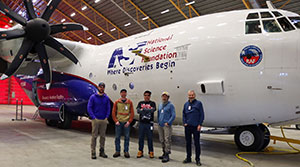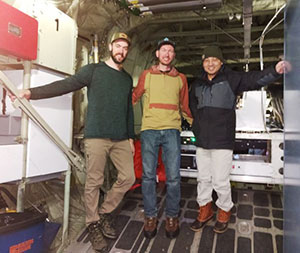UW Team Studies Possible Effects of Cold Air Outbreaks on Arctic Ice Melt
Published March 01, 2024

In the last decade or so, the Arctic ice sheet has been shrinking more every summer than in the historical record. And a particular type of cloud regime may be amplifying this warming rate.
For a period of a little more than six weeks, several faculty members in the University of Wyoming Department of Atmospheric Science and a cadre of scientists from around the world are studying whether clouds during marine cold air outbreaks over open water in the Arctic are contributing to the acceleration of ice melting in that region of the world.
The UW contingent is led by Bart Geerts, professor of atmospheric science; Jeff French, associate professor and department head of atmospheric science; and professor emeritus Jefferson Snider.
“The warming rate in the Arctic in the past few decades has been three to four times faster than the rate of global warming,” Geerts says. “And this, in turn, causes the seasonal ice sheet to melt faster such that, starting in the decade or two, the Arctic Sea is expected to be almost all ice-free every summer.
“The main reason is the ice-albedo feedback due to diminishing sea ice: When the ice is gone, more summertime solar radiation is absorbed by the open water, rather than being reflected by the ice,” Geerts continues. “But one of several other reasons is cloud feedback: There may be fewer low clouds in a warmer Arctic.”
The research expedition field campaign, dubbed CAESAR (Cold Air Outbreaks Experiment in the SubArctic Region), began Feb. 22 and will conclude April 7. CAESAR has deployed the National Science Foundation (NSF)/National Center for Atmospheric Research (NCAR) C-130 aircraft -- a converted military cargo plane -- from its base in Kiruna in northern Sweden to the northern seas and the edge of the Arctic ice sheet.
The UW Department of Atmospheric Science has contributed several instruments being used aboard the C-130, which can reach the Arctic ice sheet on an eight- to nine-hour flight, Geerts says. These instruments include the Wyoming airborne radars and lidar, and several cloud and aerosol probes. Several instruments, including the radars and a novel Raman lidar that measures temperature and humidity, were built as part of the NSF Mid-Scale Research Infrastructure award, “The Next-Generation University of Wyoming King Air Research Aircraft,” to the department, and these instruments are being deployed for the first time in CAESAR to assist in studying cold air outbreaks.
The deployment of these UW instruments is supported by UW researchers in atmospheric science. These include Eric Beamesderfer, Coltin Grasmick, Natalie Kille and Anna Robertson, all associate research scientists; Adam Majewski, a postdoctoral research associate; and Zane Little, a master technician.
“All five scientists are supported, in large part, through the cooperative agreement with NSF to operate the King Air and instruments, and this field deployment is their first one in their current positions,” Geerts says. “There is much excitement in the air in Kiruna.”
From the Clouds
Cold air outbreaks occur in the Arctic when cold air masses above the Arctic Ocean ice flow south over relatively warm water. During more intense cold air outbreaks, convective clouds may organize into “polar lows,” accompanied by strong winds, heavy snowfall and both dynamical and microphysical similarities to tropical hurricanes.
“These clouds are driven by surface heating; they are convective,” Geerts says of cold air outbreaks. “They start off the Arctic ice edge and become deeper with fetch (distance from the ice edge). Their appearance on satellite is quite characteristic. They are found near Japan, also, and off the East Coast of the U.S.

A Large Contingent
Scientists from 11 institutions are participating in the research. Besides UW, other key entities are the University of Miami; University of Oklahoma; Stockholm University, Sweden; University of Oslo, Norway; and the U.S. Naval Research Laboratory. Additionally, researchers from the University of Colorado-Boulder, Colorado State University, University of Michigan, Stony Brook University and SUNY Oswego are involved.
Paquita Zuidema, professor and chair of the Department of Atmospheric Sciences at the University of Miami, is the principal investigator (PI) on the field campaign. Greg McFarquhar, a professor of meteorology at the University of Oklahoma, and Geerts, both co-PIs, are the other scientists on the leadership team.
From UW, additional participants include Evan Newman and Shane Martrich, both UW graduate students studying atmospheric science.
“I am specifically working with the Wyoming Cloud Radar and Ka-Band Profiling Radar to observe and measure reflectivity, vertical velocities and along-track wind,” says Newman, a first-year master’s student from Fleetwood, Pa. “I am responsible for analyzing this radar data to learn about the fine-scale structures of the cold air outbreak clouds, their temporal evolution and how they vary in space. We also want to know how upstream weather conditions can impact these cold air outbreak clouds downstream.”
While in Sweden, Newman looks forward to experiencing the Swedish culture and seeing the Aurora Borealis.
Martrich, a first-year master’s student from Macungie, Pa., is not making the trip to Sweden but will have lab duties on campus. He will remotely provide quality assurance through data collected in the field. Martrich says he will then produce temporary processed data files for preliminary results before doing a deep dive at the end of the campaign and ensuring that the processed data are sound.
“Although not physically in a lab setting, it can be thought of as doing lab/field work through the processing, calibrating and providing the quality assurance remotely from Wyoming rather than doing it in Sweden,” he says. “Furthermore, this work during the field campaign is imperative, as the aerodynamics around the instrument -- while flying through clouds -- can be disrupted through a few different processes, thus creating a ‘baseline drift’ and the need for quality control in finding when the data may become unusable.”
Years in the Making
Geerts has been working on readying this field campaign for over six years. In summer 2017, he convened a group of scientists to build momentum for a large campaign to study the marine cold air outbreak cloud regime. Two proposals -- one called Cold air Outbreaks over the Marine Boundary Layer Experiment (COMBLE) to the Department of Energy for the deployment of an instrument suite on an island just off coastal northern Scandinavia, and the other for CAESAR, an airborne campaign -- were submitted.
“The intent was simultaneous observations from the ground and the air. Our target winter was 2019-2020. COMBLE was funded immediately. CAESAR was declined twice and greenlighted the third time,” Geerts recalls. “By summer 2020, COMBLE was done, and the pandemic had broken out. Because of the pandemic and subsequent technical challenges with the C-130, the CAESAR campaign was delayed from early 2022 to early 2024.”
The cost to NSF for the C-130 deployment and field support in CAESAR is about $4 million, paid to NCAR. The aggregate cost of the science -- three years of research grant funding -- is about $5 million, paid to all participating universities. UW received about $1 million, Geerts says. Of that total, Geerts and French received $678,000; Snider $100,000; and $230,000 for the deployment of the UW instruments.

